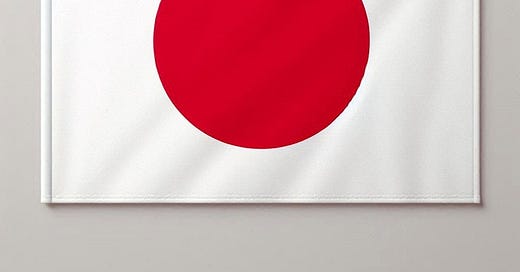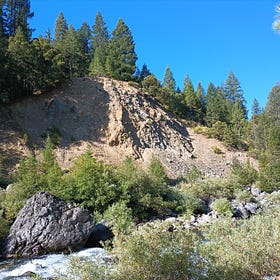In Japan
#111 - When we arrived in Tokyo from Haneda Airport, it was already dark. Our hotel was in the old part of the city, a maze of streets in a hodge podge layout that our taxi guy found difficult to
Welcome to Before I Forget . .
I’m glad you are here. Thank you for your time - and for subscribing! - It's free.
In Japan
The first time I went to Japan was in fall, for twenty days, the second in fall for ten days and the third was for ten days in the middle of winter.
It is a beautiful country. Clean and tidy. I saw one piece of graffiti - on the train going to the airport. About three-foot square on the side of a building, it looked more like a work of art; it was so out of place.
On my first trip, we visited my wife, Shino’s home. Shino (She-no) is short for Shinobu. Her home is northwest of Tokyo about two hundred miles, on the Japan Sea coast.
When we arrived in Tokyo from Haneda Airport, it was already dark. Our hotel was in the old part of the city, a maze of streets in a hodge podge layout that our taxi guy found difficult to navigate.
Eventually, we found our hotel. Our room was a pod, or cubicle, built for sleeping only. It served us well.
In the morning, we left Ueno Station on a bullet train. A short time later and a hundred miles west of Tokyo, Shino’s brother, Masahiko, picked us up. We were going to visit relatives on the way to Shino’s home.
We headed for touristy Lake Suwa, where Shino’s uncle lived.
He had arranged, as a gift to us, to have Shino and me dressed up in traditional marriage dress for pictures. What a process. Shino looked Geisha-like, and I looked strange in unfamiliar dress. I’d never been so dressed up - the Japanese equivalent of wearing a tuxedo. It was pretty neat.
We met more relatives in the late afternoon in the shadow of Mt. Fuji.
That night we stayed in a hotel with a hot spring bathing pool. We soaked in the spring with saki and the lake and the setting sun.
The next morning, we drove across mountains running north and south through Honshu, the largest and one of four main islands (there are over 14,000 islands) that make up Japan.
These are the Japan Alps. Ski country, some of the world’s best, they say. Beautiful and surprisingly large.
We arrived at Shino’s home and hometown of Itoigawa, a small city on the Japan Sea. I met Shino’s parents for the second time. They had visited us a couple of years previous.
With a little imagination, Japan looks like a seahorse. Itoigawa is about midway along the coast across from the tip of what might be seen as a dorsal fin. Their home is about a hundred yards from the seawall that runs the length of the city.
The cold Japan Sea blows wicked storms onto the mainland.
There is little actual beach.
Tetrapods, concrete forms of many experimental designs, are used to break up the wave action that pelt the shores continually through the seasons. Up to 50 percent of Japan’s coastline have them to counter erosion and flooding.
Houses rest close, side by side along the main road in a narrow strip along the coast to the city limits. Then it quickly becomes rural.
Homes on the inland side of the road, like Shino’s, have deep back yards that are reserved for gardens and vegetables. They butt up against railroad tracks beyond which are open fields that soon become the foothills of the mountains we had just crossed.
We stayed close to home and the local sights for about a week.
It is during this time that I saw, on TV, my first Sumo wrestling. There are six fifteen-day tournaments a year starting on the second Sunday of each odd month of the calendar year. I caught the one in November. The wrestlers are amazing athletes and follow rigid training disciplines. I still follow Sumo. I find it fascinating.
Also, during this time, Shino’s older brother, Takeshi, brought his family down for a visit. They lived an hour’s drive north. It was a full household.
Takeshi’s oldest son, Akira, who was then 5 or 6 years old, visited us a few years later with a friend and we went to Disneyland and then down to Acapulco for a few days, where we met my family.
Shino’s dad thought, since he had a group of able bodies gathered, we should go up into the forested hills where he had a few acres and do some brush clearing.
His intention was to plant trees for its lumber. It was a steep hillside. Some of it was level enough for growing vegetables.
So, come midmorning, eight of us went with saws and loppers and rakes and picnic baskets, across the tracks and fields and up into the hills.
Shino’s brothers set the pace, and we got far more done than I would have thought.
After a couple of hours, we took a break for lunch. Except, we forgot to bring eating utensils, i.e., chopsticks.
Readily available was a brush pile we had gathered, and chopsticks were fashioned from the thinner sticks. No problem, it gave us a laugh.
We were a tired bunch when we returned home.
We rested up and prepared for our overnight train trip the next evening down the coast and over the hills to Hiroshima.
A lot of that resting up for Dad and brothers and myself involved beer, and/or saki, and watching Sumo.
We, and Shino’s parents, would be taking a trip that would take us to the southwestern part of Honshu Island, then east along the Inland Sea to Tokyo. In Japan - 2, In Japan - 3
Thank you for reading Before I Forget . . !
For my Subscribers new and old - A post from August 18, 2023
The Golden Slide
I don’t sleep well the night before going up to the gold country. I’m restless and am usually up before the alarm. Seems I would be used to it by now but once bitten by the gold bug, the fever’s hard to break.
More posts are in my archive. Check them out.
Image by DALL-E 3










A wonderful travelog, Ron! Now, next time, post that phto of you and Shino dressed in traditional clothing. Your readers would love to see you in your 20s!
thx 🙃🙃🙃🤗🤗🤗😘😘😘😍😍😍🥰🥰🥰